
After the statement of the SBU that the Council had made software products of “1C” in the sanctions list, and the company “Eurocopter” (Ukrainian rightholder of software “1C: Enterprise”) has publicly denied this information, accountants and heads of Ukrainian companies began animatedly to discuss possible options in case it’s still going to happen. Because these programs are mostly used by the Ukrainian enterprises, especially small and medium. Experts told about the possible alternatives, writes UBR.
In September 2015, a presidential decree (No. 549) was approved the list of legal entities and physical persons of the Russian Federation against Ukraine has imposed sanctions. In the same list contains, among others, software products of Russian origin (for example, anti-virus Kaspersky Lab), and there’s no software “1C”. The last update of the list occurred on 30 November last year.
“Moreover, even sanctions BY still sold in the Ukraine. Therefore, concerns of business about banning the program from a legal point of view is groundless”, — assured the Deputy Director on legal issues of JSC “NC-it Project” (MMI Group) Iryna Kolos.
According to the business Analitika “Eurocopter” Victoria Ilchenko, in Ukraine there are more than 500 companies that sell the product under the franchise agreement.
“Therefore, if one or more companies will be found in violation of the Ukrainian legislation, according to the SBU, it will not affect the entire market,” said UBR.ua managing partner at SBT Systems Ukraine, Vice-President of the Association “it Ukraine” Dmitry Ovcharenko.
However, according to Iryna Kolos, you can prevent the scenario in which the business may lose the support of the already established programs. In this case, enterprises will either have to use an illegal software, or switch to alternative products.
The difficulties of transition
According to DP “Eurocopter” in Ukraine software products “1C: Enterprise” is about 300 thousand companies. It is a system of class ERP (Enterprise Resource Planning — enterprise resource planning), that is, corporate information system for automation of planning, accounting, control and analysis of all major business processes, and business objectives of the enterprise as a whole. It consists of various modules, such as accounting and tax accounting, warehouse management, transportation, etc.
According to Dmitry Ovcharenko, the implementation of any ERP system takes at least several months, and in the case of automation of large enterprises — up to 1 year. Accordingly, the migration process will also require time. You can not at once stop the processing of hundreds of documents (acts, bills, invoices, etc.), which are issued daily.
So even if something is forbidden, it’s not going to happen overnight. The transition to the new system will be long and some time system (old and new) will work in parallel.
Moreover, as described in the Accounting office “Standard”, promotion of the program “1C” has occurred at the state level and its disappearance would entail first and foremost the failure of GFS.
The competitive advantage of 1C is ground under the accounting standards, which by and large has changed little in many CIS countries. Therefore, most of the required software updates is not so much with the software but with the updated legislation.
“Almost 80% of small business uses 1C. There is a similar Ukrainian development, but they lose the scale of application. But in large business, there are no 1C. Here we use foreign solutions from SAP, Oracle, or Microsoft, IBM or the same Charisma from TotalSoft,” — said the regional development Manager of the company TotalSoft Roman Kifak.
For example, the company Ukroboronprom, use imported software SAP cost from $ 1 million. Is protected and contains advanced experience of foreign management company.
Ovcharenko said that even large companies implement SAP, but faced with the fact that there are no modules that take into account peculiarities of Ukrainian accounting. “And in fact, after trying these foreign modules to modify, customers began to use a parallel system of 1C for accounting and tax reporting. And the SAP is used for filing international reporting and management of the enterprise”, — explained the expert.
However, the expert urges to remember that this is commercial software with closed source, so in case of serious breakage or the need for significant updates may be the problem, if not will be respect and support from the official developer program.
Experts say that the relative stability of the accounting led to the fact that many businesses used to use 1C. But there are many alternative versions of software. And the transition is not as complicated as it might seem at first glance.
“Competitive transition — this is a standard practice of many companies when selling new software. It is that the buyer pays for the transition to the new program same or even less than annual using the old. Plus this price includes annual support for the new product,” explained Iryna Kolos.
As Roman told Kifak, some ministries that previously worked and 1C and similar to the program “the Sail” has refused from 1C. “And the next line will be “Sail”, as the roots they have in common — in Russia,” — said Roman Kifak.
What to change
In fact, as told Kifak, there are three advantages of 1C. First — the cost. It starts from a few thousand hryvnia (boxed version, which will require additional configuration specialists that cost a lot of money) and can range up to several tens or even hundreds of thousands hryvnias (all depends on the scale of the company).
The second — fastest updates. Quickly updated so as to prepare a product update starting in parallel with the adoption of amendments to Ukrainian legislation. For this there is a staff of lawyers and accountants. Other companies preparing updates takes about a week after the adoption of the next standard.
The third language. The interface can be in Ukrainian or Russian language, but frequent contact with the developers of the program have to in English which not everyone is comfortable.
Software should be prepared for possible sectoral developments. And the company that intends to withdraw from the 1S, will spend one month only in order to choose the most suitable option.
According to Kitaka, strategic enterprises will go, most likely, to products such as SAP, Oracle, or the like. After all, modern software helps to structure the work of the enterprise, which affects the efficiency of production. And the better the software the better the result.
But to pay $ 1 million for an SAP or 50-80 thousand euros (the minimum package of Charisma from TotalSoft) can only large or medium-sized business. For domestic SMEs can prove to be expensive and the development of Ukrainian IT-Enterprise, which is at the level of similar foreign products, because it is designed for medium and large business.
“For small businesses, we can advise Turkish developer Logo, which focuses on small business. The functionality there is limited, but for SMEs and many do not. Such a program would cost less than 50 thousand euros,” — said Kifak. There are cheaper versions of the programs, but, judging by the reviews of accountants, they can not become a good alternative.





